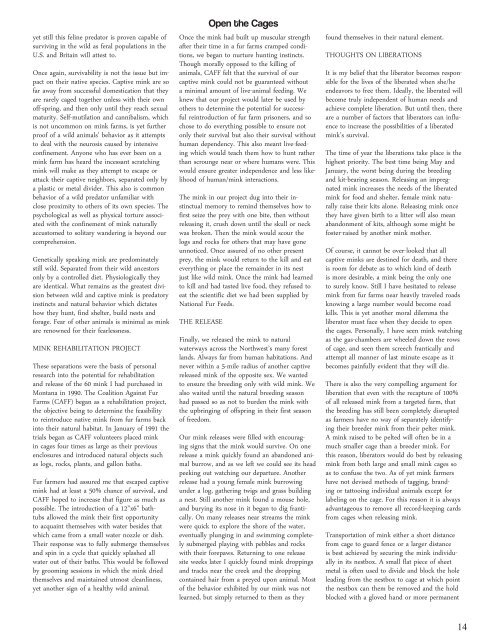Create successful ePaper yourself
Turn your PDF publications into a flip-book with our unique Google optimized e-Paper software.
yet still this feline predator is proven capable of<br />
surviving in the wild as feral populations in the<br />
U.S. and Britain will attest to.<br />
Once again, survivability is not the issue but impact<br />
on their native species. Captive mink are so<br />
far away from successful domestication that they<br />
are rarely caged together unless with their own<br />
off-spring, and then only until they reach sexual<br />
maturity. Self-mutilation and cannibalism, which<br />
is not uncommon on mink farms, is yet further<br />
proof of a wild animals’ behavior as it attempts<br />
to deal with the neurosis caused by intensive<br />
confinement. Anyone who has ever been on a<br />
mink farm has heard the incessant scratching<br />
mink will make as they attempt to escape or<br />
attack their captive neighbors, separated only by<br />
a plastic or metal divider. This also is common<br />
behavior of a wild predator unfamiliar with<br />
close proximity to others of its own species. The<br />
psychological as well as physical torture associated<br />
with the confinement of mink naturally<br />
accustomed to solitary wandering is beyond our<br />
comprehension.<br />
Genetically speaking mink are predominately<br />
still wild. Separated from their wild ancestors<br />
only by a controlled diet. Physiologically they<br />
are identical. What remains as the greatest division<br />
between wild and captive mink is predatory<br />
instincts and natural behavior which dictates<br />
how they hunt, find shelter, build nests and<br />
forage. Fear of other animals is minimal as mink<br />
are renowned for their fearlessness.<br />
MINK REHABILITATION PROJECT<br />
These separations were the basis of personal<br />
research into the potential for rehabilitation<br />
and release of the 60 mink I had purchased in<br />
Montana in 1990. The Coalition Against Fur<br />
Farms (CAFF) began as a rehabilitation project,<br />
the objective being to determine the feasibility<br />
to reintroduce native mink from fur farms back<br />
into their natural habitat. In January of 1991 the<br />
trials began as CAFF volunteers placed mink<br />
in cages four times as large as their previous<br />
enclosures and introduced natural objects such<br />
as logs, rocks, plants, and gallon baths.<br />
Fur farmers had assured me that escaped captive<br />
mink had at least a 50% chance of survival, and<br />
CAFF hoped to increase that figure as much as<br />
possible. The introduction of a 12”x6” bathtubs<br />
allowed the mink their first opportunity<br />
to acquaint themselves with water besides that<br />
which came from a small water nozzle or dish.<br />
Their response was to fully submerge themselves<br />
and spin in a cycle that quickly splashed all<br />
water out of their baths. This would be followed<br />
by grooming sessions in which the mink dried<br />
themselves and maintained utmost cleanliness,<br />
yet another sign of a healthy wild animal.<br />
Open the Cages<br />
Once the mink had built up muscular strength<br />
after their time in a fur farms cramped conditions,<br />
we began to nurture hunting instincts.<br />
Though morally opposed to the killing of<br />
animals, CAFF felt that the survival of our<br />
captive mink could not be guaranteed without<br />
a minimal amount of live-animal feeding. We<br />
knew that our project would later be used by<br />
others to determine the potential for successful<br />
reintroduction of fur farm prisoners, and so<br />
chose to do everything possible to ensure not<br />
only their survival but also their survival without<br />
human dependency. This also meant live-feeding<br />
which would teach them how to hunt rather<br />
than scrounge near or where humans were. This<br />
would ensure greater independence and less likelihood<br />
of human/mink interactions.<br />
The mink in our project dug into their instinctual<br />
memory to remind themselves how to<br />
first seize the prey with one bite, then without<br />
releasing it, crush down until the skull or neck<br />
was broken. Then the mink would scour the<br />
logs and rocks for others that may have gone<br />
unnoticed. Once assured of no other present<br />
prey, the mink would return to the kill and eat<br />
everything or place the remainder in its nest<br />
just like wild mink. Once the mink had learned<br />
to kill and had tasted live food, they refused to<br />
eat the scientific diet we had been supplied by<br />
National Fur Feeds.<br />
THE RELEASE<br />
Finally, we released the mink to natural<br />
waterways across the Northwest’s many forest<br />
lands. Always far from human habitations. And<br />
never within a 5-mile radius of another captive<br />
released mink of the opposite sex. We wanted<br />
to ensure the breeding only with wild mink. We<br />
also waited until the natural breeding season<br />
had passed so as not to burden the mink with<br />
the upbringing of offspring in their first season<br />
of freedom.<br />
Our mink releases were filled with encouraging<br />
signs that the mink would survive. On one<br />
release a mink quickly found an abandoned animal<br />
burrow, and as we left we could see its head<br />
peeking out watching our departure. Another<br />
release had a young female mink burrowing<br />
under a log, gathering twigs and grass building<br />
a nest. Still another mink found a mouse hole,<br />
and burying its nose in it began to dig frantically.<br />
On many releases near streams the mink<br />
were quick to explore the shore of the water,<br />
eventually plunging in and swimming completely<br />
submerged playing with pebbles and rocks<br />
with their forepaws. Returning to one release<br />
site weeks later I quickly found mink droppings<br />
and tracks near the creek and the dropping<br />
contained hair from a preyed upon animal. Most<br />
of the behavior exhibited by our mink was not<br />
learned, but simply returned to them as they<br />
found themselves in their natural element.<br />
THOUGHTS ON LIBERATIONS<br />
It is my belief that the liberator becomes responsible<br />
for the lives of the liberated when she/he<br />
endeavors to free them. Ideally, the liberated will<br />
become truly independent of human needs and<br />
achieve complete liberation. But until then, there<br />
are a number of factors that liberators can influence<br />
to increase the possibilities of a liberated<br />
mink’s survival.<br />
The time of year the liberations take place is the<br />
highest priority. The best time being May and<br />
January, the worst being during the breeding<br />
and kit-bearing season. Releasing an impregnated<br />
mink increases the needs of the liberated<br />
mink for food and shelter, female mink naturally<br />
raise their kits alone. Releasing mink once<br />
they have given birth to a litter will also mean<br />
abandonment of kits, although some might be<br />
foster-raised by another mink mother.<br />
Of course, it cannot be over-looked that all<br />
captive minks are destined for death, and there<br />
is room for debate as to which kind of death<br />
is more desirable, a mink being the only one<br />
to surely know. Still I have hesitated to release<br />
mink from fur farms near heavily traveled roads<br />
knowing a large number would become road<br />
kills. This is yet another moral dilemma the<br />
liberator must face when they decide to open<br />
the cages. Personally, I have seen mink watching<br />
as the gas-chambers are wheeled down the rows<br />
of cage, and seen them screech frantically and<br />
attempt all manner of last minute escape as it<br />
becomes painfully evident that they will die.<br />
There is also the very compelling argument for<br />
liberation that even with the recapture of 100%<br />
of all released mink from a targeted farm, that<br />
the breeding has still been completely disrupted<br />
as farmers have no way of separately identifying<br />
their breeder mink from their pelter mink.<br />
A mink raised to be pelted will often be in a<br />
much smaller cage than a breeder mink. For<br />
this reason, liberators would do best by releasing<br />
mink from both large and small mink cages so<br />
as to confuse the two. As of yet mink farmers<br />
have not devised methods of tagging, branding<br />
or tattooing individual animals except for<br />
labeling on the cage. For this reason it is always<br />
advantageous to remove all record-keeping cards<br />
from cages when releasing mink.<br />
Transportation of mink either a short distance<br />
from cage to guard fence or a larger distance<br />
is best achieved by securing the mink individually<br />
in its nestbox. A small flat piece of sheet<br />
metal is often used to divide and block the hole<br />
leading from the nestbox to cage at which point<br />
the nestbox can them be removed and the hold<br />
blocked with a gloved hand or more permanent<br />
4



